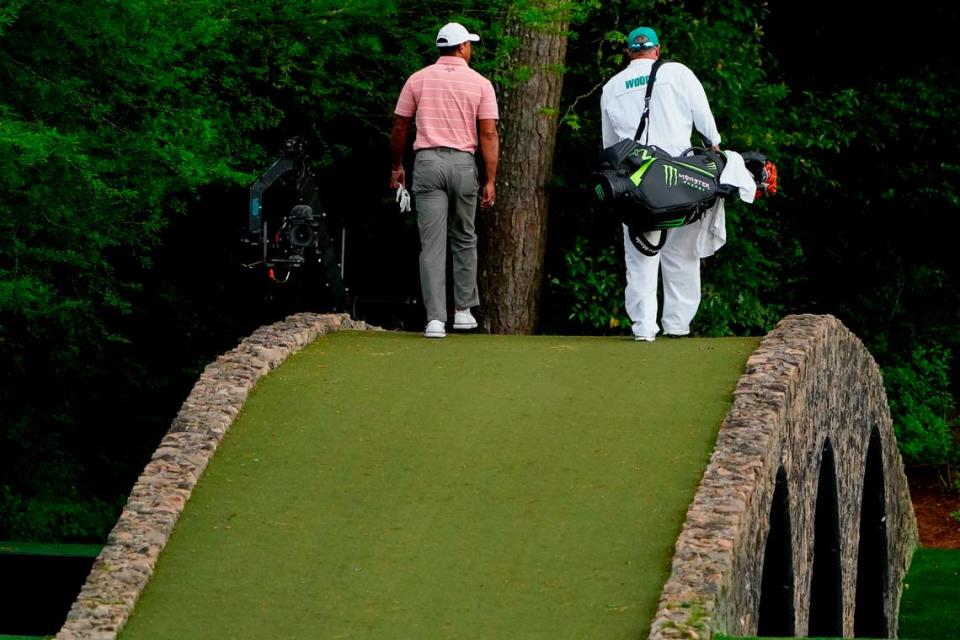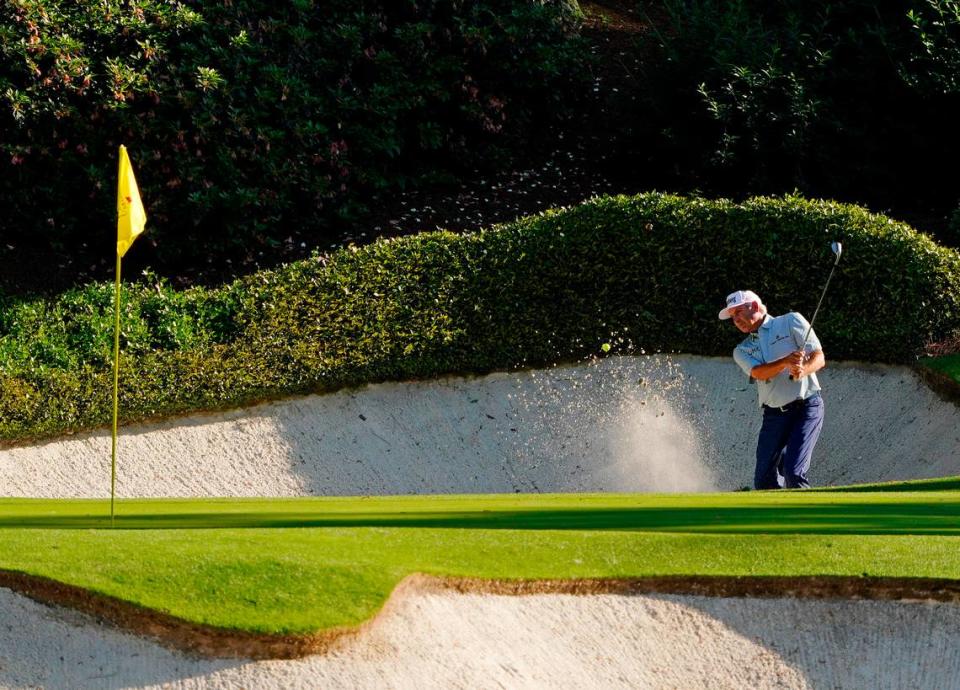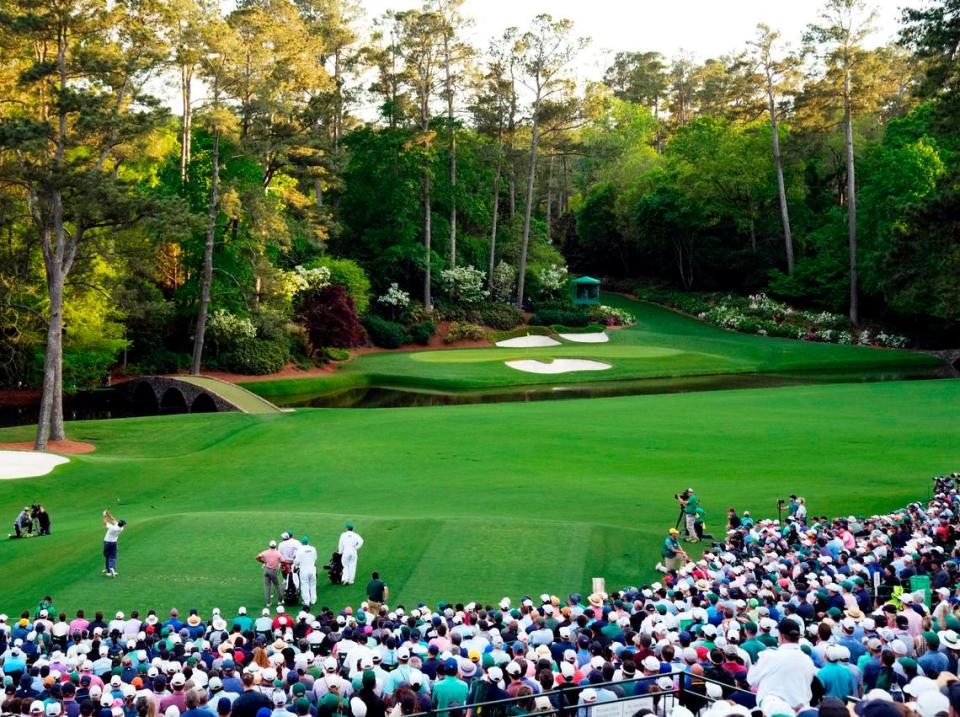Augusta National’s famous 12th hole at Amen Corner: a beauty that needs no adjustments
The scene is idyllic. The poet might choose “tranquil” or “serene” to describe the picturesque setting that features a bubbling creek and a floral rainbow amid a sea of green.
Beautiful to the eye. Terrifying to the golfer.
Welcome to Augusta National Golf Club’s 12th hole known as Golden Bell, a proverbial wolf dressed in sheep’s clothing where the Masters is so often decided.
This is the place to be. This is where drama — good and bad — unfolds. And the patrons know. They flock to the heart of Amen Corner soon after the gates open, and the stands are filled long before the first golfers arrive.
The hole stretches only 155 yards, the shortest on the fabled course. Elite golfers require only a short iron off the tee, and the distance in hardly long enough to scare those far less talented.
Yet, the history books are littered with what the golfers call “a train wreck.” Tom Weiskopf set the record for futility with a 13. Tiger Woods once posted a 10 there. Bubba Watson needed to sink a 15-foot put to salvage a 10. Jordan Spieth and Arnold Palmer threw away a green jacket here. Gene Sarazen hit three in the water and withdrew.
Tales of woe keep coming.
So, what’s going on? How can the beauty be such a beast?
Theories of how to best play the hole abound. Concrete answers are few. The best solution often is to swing and hope. Prayer might work, too.
Red Smith once wrote that the 12th “is a pretty suburb of purgatory.” And columnist Jim Murray, playing the course, reached the 12th and asked: “Do I use a 7 iron here or a St. Christopher’s medal? Help.”
The combination of swirling winds, a small target and Masters pressure provide the challenge. Players who could usually drop a 9-iron shot into a pickle barrel at 150 yards send shots all over the area from the 12th tee.
“Doubt” is the enemy and wind causes doubt. Watching golfers back off time and again before finally hitting their tee balls is telling.
“You have to be committed to the shots,” Tiger Woods said in explaining his approach.
“(The wind) it was hard to figure it out, especially down at Amen Corner,” Lucas Glover said after his 71 on Thursday. “You know, you’re at the mercy of it on some of the holes. . . . Days like this make you realize that the aura is true about the swirling wind, different spots, and all that stuff.”
The green is 26 yards deep, which suggests “no problem.” But the hourglass shape alters the perception. Due to the angle, it’s no more than 15 yards deep at any point, and the target area is perhaps half of that.
Add the wind and, well, the challenge increases.
The 12th sits on the lowest point on the course, and the landscape creates an unpredictable wind pattern.
The flags on the 11th and 12th greens, separated by perhaps 50 yards, can flutter in different directions at the same time. The tall pines sway this way and that.
One golf publication once attempted to explain the wind phenomenon by examining elevation changes, wind sheers and other such data, but that’s no help to the golfer standing on the tee.
Masters lore tells that Ben Hogan once said he would not swing on the 12th tee until he felt the wind on his left cheek. Maybe Jason Day employed that strategy in Thursday’s first round, backing away once, twice, three times before finally swinging.
Tiger Woods and Max Homa followed. None hit the green, which seems remarkable for players of their caliber.
Then again, they didn’t put their shots into Rae’s Creek — the cardinal sin.
“The tee shot at 12 is one of the four of five most important at Augusta National,” six-time Masters champion Jack Nicklaus said, and history tells why.
Just go back five years, to 2019, to Woods’ fifth Masters championship.
Brooks Koepka, two shots behind leader Francisco Molinari, put his tee ball in the creek, made double bogey — and finished one stroke behind.
Tony Finau and Molinari did the same and fell back.
Woods, meanwhile, made his par.
A year later, Woods talked about his victory and noted, “They hit it into the water and I didn’t.”
Of course, this is the scene of triumphs, too.
There’s Fred Couples’ ball miraculously stopping on the creek’s shaved bank the year he won the green jacket. Arnold Palmer received a favorable plugged-ball ruling that helped him triumph.
Claude Harmon (1947), William Hyndman (1959) and Curtis Strange (1988) recorded aces there. Scott Verplank (2003) made birdie there all four rounds. Even Thursday, Scottie Scheffler’s chip shot — sizzling across the green — hit the pin and dropped, turning a potential four into a two. Will that be important Sunday afternoon?
It’s history makes the 12th the most compelling hole at Augusta National and the fact that changes there have been minor or cosmetic tells that designers Bobby Jones and Alister MacKenzie “got it right” from the start.
Statistics show that the 12th has been the fourth-toughest hole during the 87 previous Masters, a number that made the recent suggestion by 2000 Masters champion Vijay Singh — that 10 yards be added to the hole to make it harder — so surprising.
It’s the seventh-most difficult hole through two rounds of the 2024 tournament.
Asked this week about the possibility of altering the hole, Augusta National and Masters chairman Fred Ridley said: “Never is a long time. I would say with a hundred percent certainty that it would not be lengthened during my tenure. That’s almost like asking, ‘Can we touch up the Mona Lisa a little bit?’ ”
Amen.










